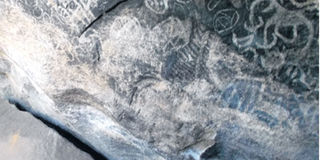Kakapel rock art

A section of the art on the rocks that shows how people lived over 2,000 years ago.
What you need to know:
- David Coulson, founder and executive chairman of TARA — Trust for African Rock Art — first heard about the site from the well-known Kenya naturalist and film maker, the late Joan Root (a TARA supporter and adviser) when she came back from a visit to Uganda in 1996.
- Stopping every few kilometres to make sure we are on the right track, we drive past the Equator at Maseno and the sugar fields of Luanda, Yala, and Mumias. The land is interspersed with huge rocks and hills.
The only people who seem to know about Kakapel are those who live nearby.
From Amagoro, very close to Malaba on the Ugandan border, a dirt road leads to Kakapel in the land of the Teso. We are here for the Kakapel Cultural Day and to see what it has recently become famous for — its ancient rock art.
It is 10 kilometres on the murram road and everyone is heading that way. It is almost 1pm — I had anticipated being here at 10am but we got lost on the road less travelled.
Stopping every few kilometres to make sure we are on the right track, we drive past the Equator at Maseno and the sugar fields of Luanda, Yala, and Mumias. The land is interspersed with huge rocks and hills.
Finally in the stifling heat, we arrive at Kakapel. I gasp at the towering rock reaching for the skies — it is lined with stick-men. If that is where the rock art is, after the sweltering climb to view it at that height, I would need to spend the night here — something we had not factored in.
ROCKY OUTCROP
There is a crowd at the site and we are met by Anthony Odera, the National Museums of Kenya (NMK) site manager.
“The rock art site is very close. I’ll take you there,” he offers. Margaret Gikonyo, the KWS ranger, and I follow him. A rocky outcrop stands sheltered by tall trees close to that enormous rock that l had anticipated climbing. And then we see the rock art sheltered in the rocky enclave. It is surreal that we are at a site that people drew on 2,000 to 4,000 years ago, long before the age of pens and pencils.
“This is Kakapel’s premier rock art site,” starts Odera. “There are different styles of art that can be seen here.”
We scan the artwork on the granite canvas.
“The clear ones are 2,000 years old,” They are of an elephant, giraffe, and tortoise shells — animals that once roamed these hills and plains which are now all cultivated. The older ones of concentric circles are 4,000 years old.
“They are possibly symbols for fertility or rain-making. They are like the ones on Mfangano Island. We haven’t done much research here, but it seems like the artwork was done by the same people — the Twa, who were hunter-gatherers,” explains Odera.
There are masses of people at the rock art site, including a representative of the Teso king from Uganda who joins in a final jig with the dancers.
I strike up a conversation with a young girl by the rock. Twelve-year-old Esther Etyang is a pupil at Kakoli Primary School with dreams of being a neuro-surgeon.
“These paintings show how people lived in caves in those days. They painted to record their lives here. I think the paintings are about 100 years old,” she tells me. The village drunk thinks it is God who drew the artwork.
While we have been engrossed in the rock art and the day’s entertainment by the Teso, who are related to the Karamojong and Turkana, Musa Bett, the KWS driver, has scaled the sky-touching rock and is back down. He is exhilarated from the climb.
RESTORED TO ORIGINAL FORM
David Coulson, founder and executive chairman of TARA — Trust for African Rock Art — first heard about the site from the well-known Kenya naturalist and film maker, the late Joan Root (a TARA supporter and adviser) when she came back from a visit to Uganda in 1996.
Coulson and the TARA Founding Trustee, Alec Campbell, visited in 1997, recorded the site, and published photos and a drawing from that visit in their beautiful coffee-table book, African Rock Art, Paintings and Engravings on Stone (Harry N. Abrams, New York, 2001). However, a few years later, it was vandalised with graffiti. It led to talks between TARA and the NMK to have it gazetted. With support from Safaricom, TARA brought in an expert from the US to clean the graffiti.
Now that I know how far the paintings are, l look forward to the next trip when I will actually scale the 700-foot high granite monolith, search for other sites, and learn more about the Teso kingdom.




